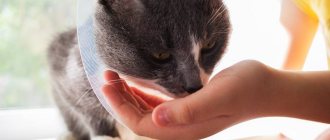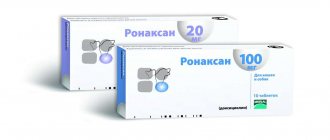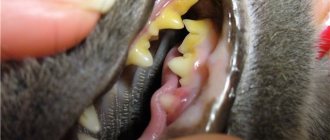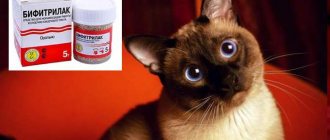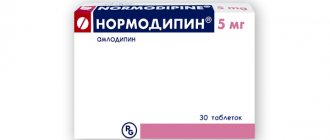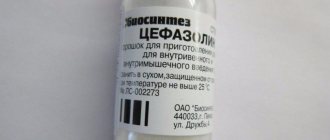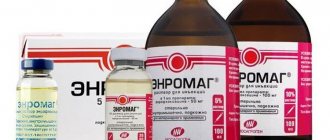Pharmacology of itraconazole in animals
Pharmacological action - itraconazole is a fungistatic substance from the group of triazole derivatives
, which, like imidazoles (clotrimazole, ketoconazole, etc.), act mainly by changing the structure of the cell membranes of fungi sensitive to the drug, which increases the permeability of the membranes and allows the contents of the cell to leak out of it, and also prevents the absorption of precursors of purine and pyrimidine derivatives.
Itraconazole has activity against a number of pathogenic fungi, including yeasts and dermatophytes, that cause pathologies in dogs, cats and other animal species. In vivo studies using laboratory models have shown that itraconazole has a fungistatic effect against many strains of pathogenic fungi:
- Candida
- Aspergillus
- Cryptococcus
- Histoplasma
- Trypanosoma cruzi
- Blastomyces
How to give Clotrimazole to a cat?
Clotrimazole is a powerful drug against fungal infections.
Its base is synthetic imidazole. It effectively destroys dermatophytes, candida, gram-positive and gram-negative bacteria. Clotrimazole for cats can also be used. Most often used to treat lichen. This product has many variations for external use. These are gels, solutions and creams. There is also a version in tablet format. On sale it can be found under different names, for example: Fungin, Kandizol and Amyclone.
Veterinarians often advise cat owners to always have clotrimazole in the form of an ointment in their home medicine cabinet. This will help neutralize the inflammatory process in time.
Pharmakinetics of the drug
Pharmacokinetics. In cats, dogs and other animals, the absorption of itraconazole is highly dependent on the pH of the animal's stomach contents and the availability of food. When the drug is administered on an empty stomach, bioavailability is only 50% or even less, while in the presence of food it reaches 100%.
Intraconazole in animals has a very high ability to bind to proteins and is widely distributed throughout the body, especially in tissues rich in lipids (the drug is very lipophilic).
Concentrations of itraconazole in the skin, female reproductive system, and pus in dogs, cats, and other animal species are higher than its concentrations in serum. In cerebrospinal fluid, intraocular fluid and in the secretions of the salivary glands in animals, itraconazole is found in minimal concentration.
Itraconazole in cats and dogs is metabolized in the liver to many metabolites, including hydroxyitraconazole, which is the active one. In humans, the half-life from serum is 21-64 hours. Elimination in animals is probably characterized by saturation.
How to store?
In order for Clotrimazole to retain all its medicinal properties until the end of its shelf life, it must be provided with the correct storage conditions. To do this, the package with the medicine is placed in a dry, dark place, to which small children and animals do not have access. The air temperature in the room where the medication is located should not exceed 25 degrees Celsius. The shelf life is 3 years, after which Clotrimazole must be disposed of; using an expired drug is strictly contraindicated.
Contraindications to the use of intaconazole in pets
Effect on reproduction. According to the instructions for use, itraconazole should not be used in animals that are hypersensitive to it or to other azole antifungal drugs; In animals with impaired liver function or achlorhydria (hypochlorhydria), itraconazole is prescribed only if the effectiveness of treatment outweighs the risk of side effects.
In laboratory animals, intraconazole in high doses (5-20 times higher than recommended) had dose-dependent toxic effects in females, exhibited fetotoxicity and teratogenicity. The safety of using the drug during pregnancy has not been established, so it can be prescribed in this case only if the effectiveness of treatment outweighs the likely risk. Itraconazole passes into breast milk, but the significance of this fact is not clear.
Is ringworm transmitted to humans?
The main danger of the disease is that lichen is contagious to humans. In this case, people can be affected in any part of the body (arms, legs, etc.), often the skin under the hair on the head. Pink spots appear with clear edges. They may be slightly raised above the skin. Hair on the spots always falls out and grows back only after the end of the course of therapy and cure.
Most often, children of preschool age, who have not yet developed immunity, and adults who have a weak immune system are infected with lichen. In people with a strong, healthy body and high immunity, fungal spores can live on the skin for quite a long time and remain in a suppressed state.
Side effects of itraconazole in cats, dogs and other species
Warnings in Dogs: Probably the most serious side effect of the drug is hepatotoxicity.
Approximately 10% of dogs treated with itraconazole 10 mg/kg/day and 5% of dogs treated with 5 mg/kg/day experienced significant hepatotoxicity requiring immediate discontinuation of the drug (at least temporarily). Liver damage is accompanied by a significant increase in ALT activity. Anorexia is also often a symptomatic indicator of toxicity, usually appearing in the second month of drug treatment. Some dogs receiving high doses of itraconazole (10 mg/kg/day) may develop skin lesions such as ulceration/vasculitis, swelling of the limbs, requiring dose reduction.
In cats, side effects are likely to be dose dependent. Gastrointestinal disturbances (anorexia, weight loss, vomiting), hepatotoxicity (increased ALT levels, jaundice) and depression have been described.
If side effects occur and ALT levels increase in animals, the use of the drug should be discontinued. Once ALT levels have returned to normal and other side effects have subsided, the drug may be reintroduced if necessary at a lower dose or with an extended dosing interval and intensive monitoring.
Signs and symptoms
The incubation period of the disease is almost 3 months, so symptoms may not appear immediately. At the initial stage, it is almost impossible to recognize the first signs and determine lichen in a cat, but already at this stage the pet becomes infectious to the people and animals around it.
The main symptoms of ringworm in cats:
- deterioration in the condition of the coat is expressed in its breaking off, dullness and greasy;
- in some places bald spots appear, on which broken hairs are visible, gradually this area becomes more bare;
- bald areas become pink (less often gray-brown) and begin to become covered with scales and crusts;
- the animal loses its appetite, becomes lethargic and apathetic;
- due to constant itching, the cat begins to actively itch and bleeding scratches appear;
- when the claws are damaged, they become deformed;
- Over time, blisters may appear on the surface of the epidermis, which become covered with crusts, and if a secondary infection occurs, ulcers may appear.
The degree of damage to the skin and fur manifests itself depending on the state of health and immunity of the animal: in a healthy cat, only 1-2 spots are possible, in a weakened cat, lichen covers large areas of the body. The most commonly affected areas are the head, neck, muzzle, ears, back, tail and paws in the claw area.
Overdose and acute toxicity of itraconazole in cats, dogs and other animal species
Information regarding the acute toxicity of itraconazole is very limited.
According to the instructions, oral administration of antacids will help reduce absorption. In case of significant overdoses, bowel cleansing should be performed and, if necessary, maintenance treatment should be prescribed. Itraconazole cannot be removed by dialysis.
Studies in dogs given itraconazole 40 mg/kg orally daily for 3 months showed no apparent signs of toxicity.
Drug interactions For best absorption of itraconazole, an acidic environment is required, so antacids, H2-blockers (cimetvdine, ranitidine, etc.) or didanosine can cause a marked decrease in the absorption of itraconazole. Didanosine should not be prescribed simultaneously with itraconazole; the other drugs listed above can be given 2 hours after itraconazole administration, if necessary.
Itraconazole may increase prothrombin time in cats, dogs, and other pet species
receiving warfarin or other coumarin anticoagulants. Rifampin (rifampicin) may increase the rate of metabolism of itraconazole, so dose adjustment of the latter is recommended.
According to the instructions for use, itraconazole may reduce the metabolism of phenytoin or cyclosporine. The veterinary significance of this interaction is unclear.
Intraconazole, when prescribed concomitantly with terfenadine or yastemizole, may increase the likelihood of cardiovascular disorders, so if itraconazole is necessary, the best option is to use another antihistamine.
Intraconazole may increase serum concentrations of digoxin in animals; Monitoring serum digoxin levels is recommended.
According to the label, itraconazole increases serum concentrations of oral antidiabetic drugs in dogs and cats (eg, chlorpropamide, glipizide), which can lead to hypoglycemia.
Co-administration of ketoconazole, itraconazole, intravenous miconazole or troleandomycin with cisapride may lead to an increase in the concentration of the latter with subsequent ventricular arrhythmia. At this time, the manufacturer states that cisapride should not be co-administered with these drugs.
Effects on Laboratory Values Itraconazole may cause hypokalemia or, in a small percentage of patients, increased results on liver function tests.
Intraconazole doses for different animal species
For dogs with systemic mycoses, itraconazole is prescribed
:
- at a dose of 5 mg/kg per os 1-2 times a day; for rapidly progressing, life-threatening diseases of the animal, the possibility of adding amphotericin B should be considered;
- at a dose of 5 mg/kg per os 1-2 times a day; The author usually recommends higher doses, but if toxicity develops, the dose should be reduced.
Doses of itraconazole in cats for systemic mycoses
caused by fungi sensitive to the drug:
- at a dose of 5 mg/kg per os 1-2 times a day; Higher doses are usually recommended, but if toxicity develops, the dose should be reduced.
For generalized dermatophytosis in cats, itraconazole is used in the dose:
- at a dose of 10 mg/kg per os 1 time per day
For systemic mycoses of cats, intraconazole is prescribed in the dose:
- at a dose of 5 mg/kg per os 1-2 times a day; for rapidly progressing, life-threatening diseases of the animal, the possibility of adding amphotericin should be considered.
For systemic mycoses, generalized dermatophytosis, Dematiaceous lesions in cats, itraconazole is used in doses:
- in doses of 5-10 mg/kg per os every 12-24 hours
Itraconazole drugs are widely used in horses.
For equine aspergillosis, itraconazole is given in doses
:
- at a dose of 3 mg/kg 2 times a day.
The method for preparing the itraconazole suspension is provided by the manufacturer with the following warnings in the instructions for use:
- bioavailability data are not provided;
- Use the drug only if there are no other options.
Pour the contents of 24 100 mg capsules into a glass mortar. Add 4-5 ml of 95% ethyl alcohol USP and leave for 3-4 minutes to soften. Grind to a thick paste, after the alcohol evaporates, a powder remains. Slowly mix in 15 ml simple syrup. Transfer the resulting mass into a 60 ml amber glass bottle and, rinsing the mortar with simple syrup, bring to 60 ml. Mix well and place in the refrigerator. The remaining suspension after use is discarded after 35 days.
Routes of transmission of ringworm
Spores of the fungus that causes the disease can spread quickly through the air, in the aquatic environment and through clothing.
Main routes of transmission:
- in direct contact with a sick animal (if protective equipment is not used);
- with indirect contact, infection can occur through pet care items - a bed, food bowls, harness or leash;
- through other carriers of infection - rodents (mice and rats);
- in the environment, spores can spread with water or through the air, through soil, sand, garbage, upon contact with which the fungus begins to develop;
- through items of clothing or shoes of the owner or other people coming into the house.
Learn about essential antimicrobials in animals
- Trichopolum for animals
- Instructions for the use of baytril in veterinary medicine
- Metronide for animals (instructions for use, doses, indications and contraindications)
- Instructions for the use of ceftriaxone in veterinary medicine (Ceftriaxone). Explore the breadth of the antibacterial effect of ceftriaxone in animals
- Explore the breadth of Metrogyl's antibacterial effect in animals
- Instructions for the use of doxycycline in animals. Study the breadth of doxycycline's antibacterial effects in animals. Calculate the optimal dose of the drug for different types. Improve therapy effectiveness by 140%
- Metronidazole (Metronidazole) for animals (instructions for use in veterinary medicine, doses, indications and contraindications)
- Atovaquone for animals
- Azithromycin for animals

